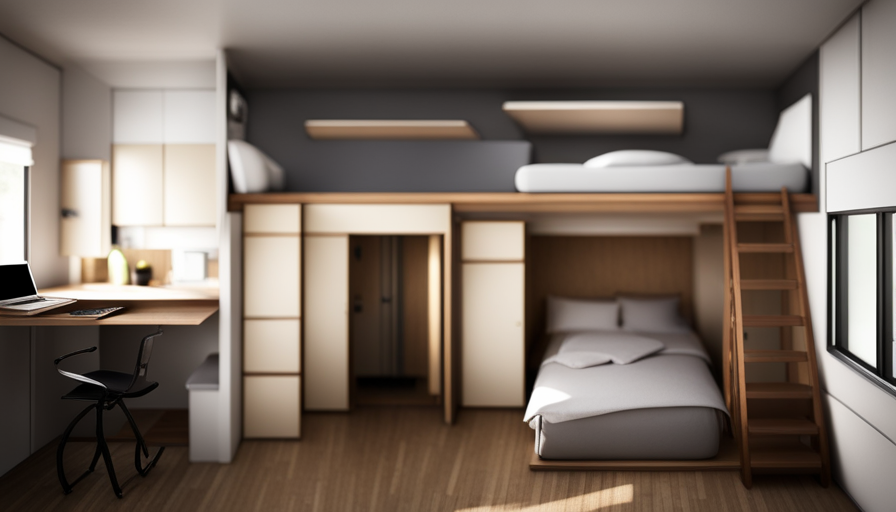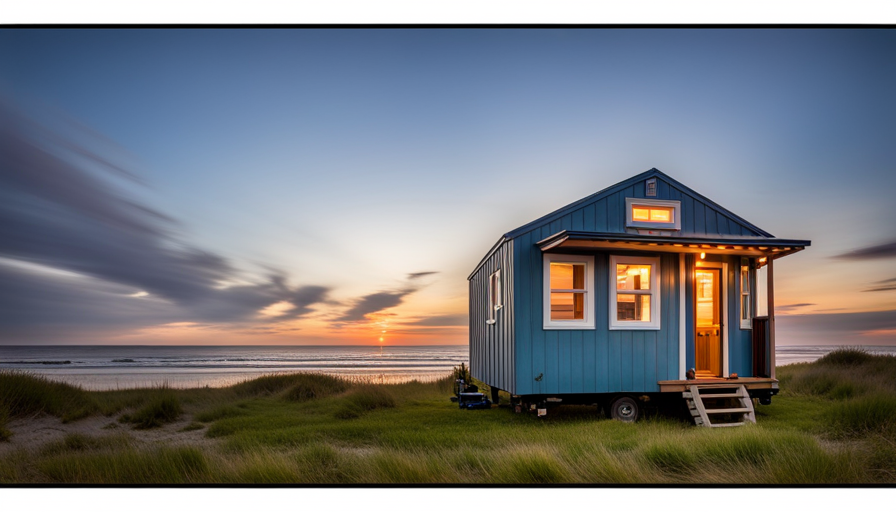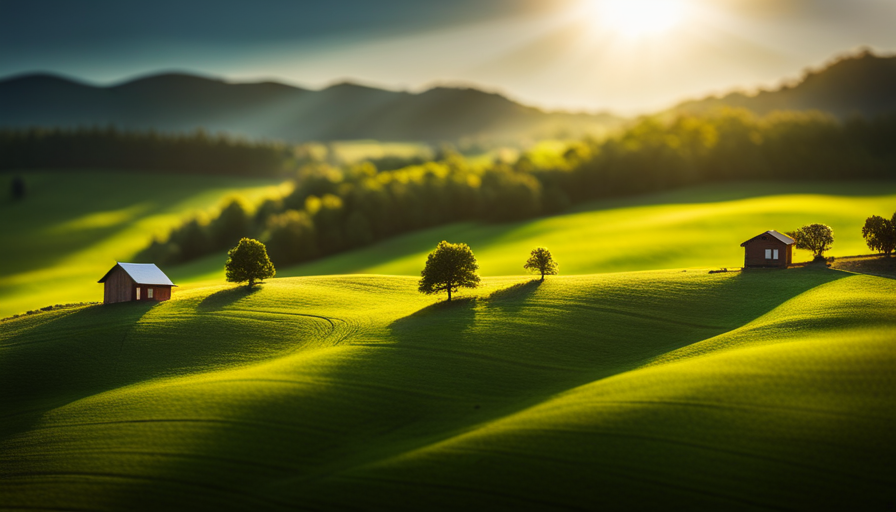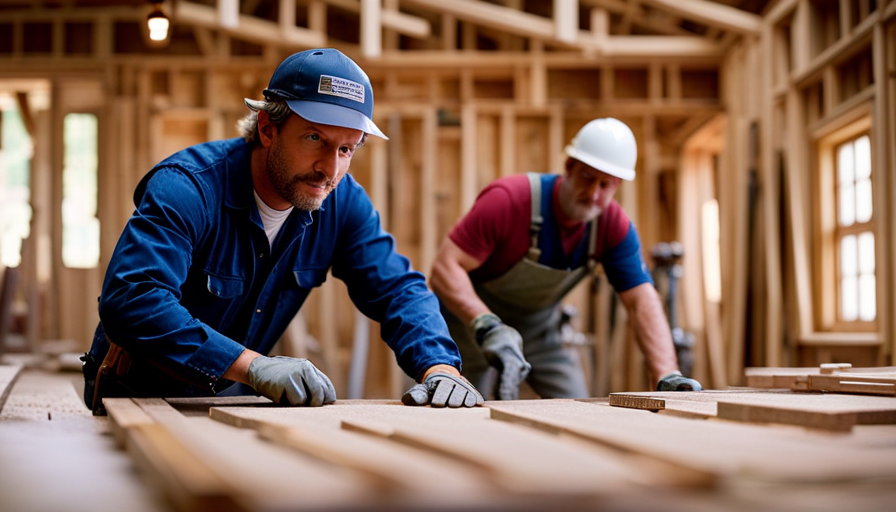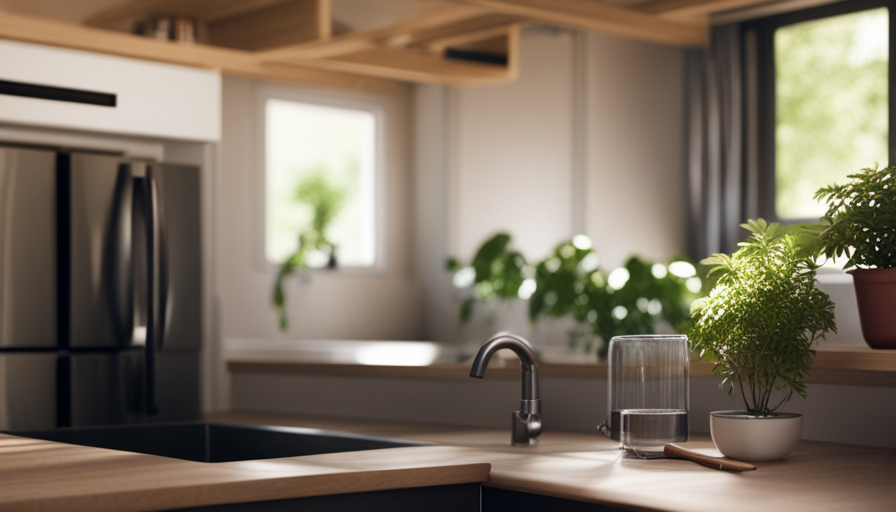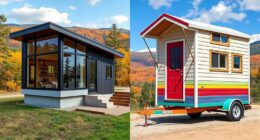Have you ever felt overwhelmed by the burden of increasing bills, struggling to keep your head above water? Imagine yourself peacefully floating in a sturdy, small raft, watching your financial concerns drift away. This is the power of the tiny house movement, a creative housing choice that provides greater cost savings than you realize.
With its minimal construction and maintenance costs, lower energy consumption, and reduced property taxes, the tiny house offers a lifeline of affordability in a world dominated by soaring housing prices. But that’s not all – the tiny house also opens up a world of affordable financing options, DIY and upcycling opportunities, and potential for rental income.
By embracing a minimalist lifestyle and simplified living, you can not only save money, but also find a sense of freedom and fulfillment that comes from breaking free from the shackles of excessive spending. So join me as we explore the incredible ways in which the tiny house can help you navigate the treacherous waters of financial stress and emerge on the shores of financial stability.
Key Takeaways
- Minimal construction and maintenance costs
- Financial independence and opportunity for savings or investments
- Reduced energy consumption and lower energy bills
- Affordable financing options and personalized financing choices
Minimal Construction and Maintenance Costs
With its minimal construction and maintenance costs, a tiny house will save you a significant amount of money in the long run. These small dwellings have gained popularity due to their low environmental impact and the financial independence they provide.
The construction of a tiny house requires fewer materials and labor compared to a traditional home, resulting in lower costs. Additionally, the compact size of a tiny house means that maintenance expenses, such as painting or repairing, are also reduced. This translates into substantial savings over time.
Furthermore, owning a tiny house allows for financial independence. With lower construction and maintenance costs, individuals can save money or invest in other areas of their lives. The reduced financial burden of a tiny house enables people to live with less debt and more financial freedom. It also provides an opportunity to downsize and simplify their lifestyle, focusing on experiences rather than material possessions.
In addition to the financial benefits, tiny houses also promote lower energy consumption. The smaller size of these homes requires less energy for heating, cooling, and overall maintenance. This leads to decreased utility bills and a smaller carbon footprint.
By transitioning to the next section about "lower energy consumption," we can explore how tiny houses contribute to sustainability and energy efficiency.
Lower Energy Consumption
Diminish your energy expenses by dwelling in a diminutive domicile. Living in a tiny house offers the advantage of lower energy consumption, resulting in significant savings on your monthly bills.
One way to achieve this is by using energy-efficient appliances. These appliances are designed to use less electricity without compromising their functionality. By investing in these appliances, you can reduce your energy consumption and ultimately save money.
Another way to lower your energy consumption in a tiny house is by harnessing renewable energy sources. Solar panels, for example, can be installed on the roof of your tiny house to generate electricity from the sun. This not only reduces your reliance on the grid but also provides a sustainable and cost-effective solution for powering your home. Additionally, using natural light through strategically placed windows and skylights can minimize the need for artificial lighting during the day.
Incorporating proper insulation and ventilation in your tiny house can also contribute to reducing energy consumption. Well-insulated walls, floors, and roofs help maintain a comfortable indoor temperature without the need for excessive heating or cooling. Efficient ventilation systems, such as energy recovery ventilators, can ensure a constant supply of fresh air while minimizing energy loss.
By adopting these energy-saving measures, tiny house dwellers can significantly lower their energy consumption and save money in the long run. Reduced energy expenses are just one of the many ways that living in a tiny house can help you achieve financial freedom and a more sustainable lifestyle.
Next, let’s explore how living in a tiny house can lead to reduced property taxes.
Reduced Property Taxes
Living in a tiny house can result in a noticeable decrease in property taxes, providing homeowners with extra financial flexibility. One of the main reasons for this is that tiny houses have a lower property value compared to traditional homes. Because property taxes are based on the assessed value of a property, having a smaller and less expensive house means paying less in taxes.
Additionally, some states offer tax deductions specifically for tiny homes. These deductions can further reduce the amount of property taxes homeowners have to pay each year.
Reduced property taxes are a significant advantage of living in a tiny house. Not only does it save homeowners money, but it also allows them to allocate those funds towards other important areas of their lives. This could include paying off debt, saving for the future, or investing in their overall well-being.
Transitioning to the subsequent section about affordable financing options, it is important to consider how reduced property taxes can contribute to the overall affordability of a tiny house. By minimizing the tax burden, homeowners have more financial resources available to explore affordable financing options that can help make their dream of owning a tiny house a reality.
Affordable Financing Options
One great aspect of owning a tiny home is the availability of affordable financing options that can help make your dream a reality. Tiny house financing is a growing trend that allows individuals to purchase or build their own tiny homes without breaking the bank.
Here are five affordable financing options for tiny houses:
-
Personal loans: Many banks and credit unions offer personal loans specifically for tiny house construction or purchase. These loans often have lower interest rates and longer repayment terms than traditional mortgages.
-
RV loans: Since tiny houses are often built on wheels and meet certain size and weight requirements, they can be financed with RV loans. These loans typically have lower interest rates and longer repayment terms than traditional mortgages.
-
Tiny house builders’ financing: Some tiny house builders offer financing options for their customers. These arrangements can be tailored to fit your specific needs and budget.
-
Peer-to-peer lending: Online platforms connect borrowers and lenders directly, providing an alternative to traditional banks. Peer-to-peer lending can offer competitive interest rates and flexible repayment terms.
-
Rent-to-own options: Some tiny house companies offer rent-to-own programs, allowing you to rent a tiny home with the option to purchase it in the future. This can be a great way to test out tiny house living before committing to ownership.
Affordable financing options make it easier for people to embrace the tiny house movement and experience the benefits of a minimalist lifestyle and reduced spending.
Minimalist Lifestyle and Reduced Spending
Imagine how much more freedom you could have by simplifying your life and spending less – what if you could achieve that through a minimalist lifestyle? Living in a tiny house encourages a minimalist lifestyle, which ultimately leads to reduced spending. With limited space, you’re forced to prioritize your possessions and only keep the essentials. This mindset translates into cost-effective furniture choices and a focus on DIY home decor.
In a tiny house, every square inch counts, so it’s important to choose furniture that’s both functional and cost-effective. Multi-purpose furniture like sofa beds, foldable tables, and storage ottomans can help maximize space and minimize expenses. Additionally, opting for second-hand or repurposed furniture can significantly reduce costs. Many tiny homeowners also embrace DIY projects to personalize their space. From building custom shelves to creating unique decorations, the possibilities are endless and often budget-friendly.
By adopting a minimalist lifestyle, you’ll also find yourself spending less on unnecessary items. With limited space, there’s less room for impulse buys and unnecessary clutter. Instead, you’ll focus on buying only what you truly need and value. This mindset shift can lead to significant savings over time.
In the next section about mobility and flexibility, we’ll explore how living in a tiny house allows for a more flexible and mobile lifestyle, opening up new opportunities for adventure and exploration.
Mobility and Flexibility
Get ready to experience a whole new level of freedom and adventure with the mobility and flexibility that comes with living in a tiny house. The portability of these compact dwellings opens up a world of travel opportunities, allowing you to easily move your home to different locations. Here are five ways that mobility and flexibility can enhance your tiny house lifestyle:
-
Portability: With a tiny house, you can hitch it to a trailer and take it wherever you want to go. Whether it’s a weekend getaway or a cross-country road trip, you have the freedom to explore new places without leaving the comfort of your own home.
-
Minimal setup: Setting up a tiny house is quick and hassle-free. Unlike traditional homes, you don’t have to deal with complicated installations or extensive packing. Just find a suitable spot and you’re ready to start living.
-
Flexibility in land use: Tiny houses can be parked on various types of land, including campgrounds, family properties, or even rented spaces. This flexibility allows you to choose affordable or scenic locations based on your preferences.
-
Environmental impact: By living in a tiny house, you can reduce your carbon footprint. Moving your home to different areas allows you to experience and appreciate different environments while minimizing your impact on a single location.
-
Community exploration: Living in a tiny house enables you to become part of different communities. You can choose to stay in one place for an extended period, immersing yourself in the local culture, or move frequently to experience and connect with various communities.
Embracing the mobility and flexibility of a tiny house lifestyle opens up a world of possibilities. In the next section, we’ll explore the affordable land options that complement this lifestyle seamlessly.
Affordable Land Options
Moving on to the current subtopic, ‘Affordable Land Options’, I want to highlight how tiny houses can provide an opportunity for land accessibility. One of the biggest advantages of living in a tiny house is the flexibility it offers in terms of where you can live. With a smaller footprint, it becomes easier to find land options that are more affordable and accessible.
When it comes to purchasing land for a tiny house, there are several factors to consider, such as zoning regulations. These regulations determine where and how you can legally park or build your tiny house. It’s important to research and understand these regulations before investing in land. However, compared to traditional homes, tiny houses generally have more flexibility in terms of zoning regulations. Some areas have specific zoning laws that allow for tiny houses, while others may have more relaxed regulations for accessory dwelling units.
To better understand the relationship between tiny houses and land accessibility, let’s take a look at the following table:
| Land Accessibility | Tiny House Suitability | Zoning Regulations |
|---|---|---|
| Limited | Yes | Restrictive |
| Moderate | Yes | Flexible |
| Abundant | Yes | Accommodating |
As you can see, tiny houses are well-suited for areas with limited land accessibility and more restrictive zoning regulations. They provide a viable housing option in situations where traditional homes may not be feasible.
In the next section, we will explore the DIY and upcycling opportunities that come with living in a tiny house, showcasing the creative possibilities that can help save even more money.
DIY and Upcycling Opportunities
Embrace your inner creativity and discover the endless possibilities for DIY and upcycling in a tiny house, where you can transform discarded materials into something extraordinary.
In a tiny house, every square inch matters, and DIY furniture becomes a practical and cost-effective solution. By repurposing materials, you can create unique and personalized pieces that perfectly fit your space and style.
To evoke an emotional response in the audience, consider the following sub-lists:
-
Reduce waste: Repurposing materials not only saves money but also helps reduce waste and minimize our environmental impact. By giving new life to old items, we contribute to a more sustainable future.
-
Express your individuality: DIY projects allow you to showcase your personality and creativity. Whether it’s a repurposed wooden pallet turned into a stylish coffee table or vintage crates transformed into shelves, each piece tells a story and adds character to your tiny home.
-
Sense of accomplishment: Creating your own furniture and decor from repurposed materials can be incredibly satisfying. It gives you a sense of accomplishment and pride, knowing that you have crafted something beautiful and functional with your own hands.
By embracing DIY and upcycling in a tiny house, you not only save money but also create a unique and environmentally-friendly living space. Decreased clutter and simplified living go hand in hand with the DIY mindset, as we’ll explore in the next section.
Decreased Clutter and Simplified Living
After exploring the DIY and upcycling opportunities that come with tiny house living, it’s important to discuss another significant benefit: decreased clutter and simplified living.
One of the main reasons why tiny houses save you money is because they encourage a minimalist lifestyle, which leads to increased mindfulness and improved mental health. Living in a tiny house requires you to carefully evaluate your belongings and prioritize what is truly necessary. This process of decluttering not only saves you money by reducing the need for storage space and excessive purchases, but it also allows you to focus on what truly matters in your life.
By living with less, you become more aware of your consumption habits and develop a greater appreciation for the things you do have. In addition to the financial savings, this simplified way of living can have a positive impact on your mental well-being. Many individuals find that living in a tiny house helps them feel more content and less stressed. With fewer possessions to manage and a smaller space to maintain, there is a sense of freedom and clarity that comes with living a simpler life.
Now, let’s explore another way that tiny houses can save you money: the potential for rental income.
Potential for Rental Income
One exciting aspect of tiny house living is the income potential it offers through renting out your small space to others. With the rising popularity of tiny homes, the rental market for these unique properties is also growing. This presents an opportunity for tiny house owners to generate additional income and offset their own housing costs.
Here are three key factors that contribute to the rental income potential of tiny houses:
-
Increasing demand: The rental market trends show a growing interest in alternative and sustainable living options. Many people are attracted to the idea of experiencing a minimalist lifestyle in a cozy and affordable tiny house.
-
Flexibility: Tiny houses can be easily transported, allowing owners to rent out their space in different locations. This flexibility enables owners to tap into various rental markets and potentially maximize their rental income.
-
Affordability: Compared to traditional houses or apartments, tiny houses generally have lower construction costs and maintenance expenses. This affordability makes them an attractive option for renters who are looking to save money without compromising on comfort.
The rental income potential of tiny houses is influenced by the increasing demand for alternative living options, the flexibility to rent in different locations, and the affordability they offer. Renting out a tiny house can be a smart financial decision for those looking to save money or generate additional income.
Frequently Asked Questions
Are there any downsides to living in a tiny house?
Living in a tiny house may seem like a dream come true, but there are a few downsides to consider. Firstly, the minimalist lifestyle required can be quite challenging for some, as it means letting go of many belongings and living with limited space.
Additionally, the small size of a tiny house can lead to social isolation, as it may be difficult to entertain guests or have enough space for social activities.
However, these downsides are outweighed by the financial benefits and the sense of freedom that living in a tiny house can bring.
Can a tiny house be built to withstand extreme weather conditions?
Yes, a tiny house can be built to withstand extreme weather conditions by adhering to building codes and using appropriate insulation materials. Building codes ensure that the structure meets safety standards, while insulation materials help regulate temperature and protect against harsh weather. By implementing these measures, a tiny house can provide a safe and comfortable living environment even in extreme weather conditions.
How do tiny houses affect the resale value of a property?
When it comes to the resale value of a property, tiny houses can have a significant impact. Due to their unique nature and growing popularity, they may attract a niche market of buyers who appreciate the minimalist lifestyle.
However, it’s important to consider the potential limitations. The limited space and unconventional design may not appeal to everyone, potentially affecting the property’s marketability. Therefore, while a tiny house can be a cost-effective property investment, it’s crucial to research the local market and target the right audience to maximize resale value.
What are some common challenges faced by tiny house owners?
Challenges faced by tiny house owners include limited space for storage and living, requiring creative solutions for organizing belongings. Maintenance can be demanding due to the compact size, requiring regular upkeep and repairs. Space utilization is crucial to maximize functionality, as every inch counts.
These challenges necessitate efficient use of space through smart design choices and multi-purpose furniture. Overcoming these obstacles can result in a comfortable and enjoyable living experience in a tiny house.
Are there any legal restrictions or regulations when it comes to living in a tiny house?
Living in a tiny house can be subject to legal restrictions and zoning regulations. These regulations vary depending on the location, but they may include minimum square footage requirements, restrictions on where tiny houses can be parked or built, and regulations on utilities and sewage systems. It’s important to research and comply with these regulations to avoid fines or legal issues.
Now, let’s discuss how living in a tiny house can save you money.
Conclusion
In conclusion, I never could have imagined how much money I’d save by living in a tiny house. It’s like the universe conspired to bring me financial freedom.
The minimal construction and maintenance costs, lower energy consumption, and reduced property taxes have all aligned perfectly to save me a fortune.
With affordable financing options, DIY opportunities, and the potential for rental income, my tiny house journey has truly been a serendipitous adventure.
It’s amazing how a simple decision can lead to such an abundance of savings.
Hi, I’m Emma. I’m the Editor in Chief of Tiny House 43, a blog all about tiny houses. While tree houses are often associated with childhood, they can be the perfect adult retreat. They offer a cozy space to relax and unwind, surrounded by nature. And since they’re typically built on stilts or raised platforms, they offer stunning views that traditional homes simply can’t match. If you’re looking for a unique and romantic getaway, a tree house tiny house might just be the perfect option.
